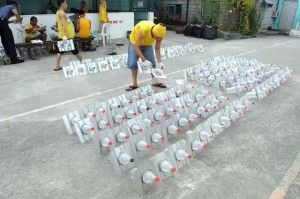Comparison of different solar reactors for household disinfection of drinking water in developing countries: evaluation of their efficacy in relation to the waterborne enteropathogen Cryptosporidium parvum. Transactions of the Royal Society of Tropical Medicine and Hygiene, Sept 2012.
H. Gómez-Cousoa, et al.
Solar water disinfection (SODIS) is a type of treatment that can significantly improve the microbiological quality of drinking water at household level and therefore prevent waterborne diseases in developing countries. Cryptosporidium parvum is an obligate protozoan parasite responsible for the diarrhoeal disease cryptosporidiosis in humans and animals. Recently, this parasite has been selected by the WHO as a reference pathogen for protozoan parasites in the evaluation of household water treatment options.
In this study, the field efficacy of different static solar reactors [1.5 l transparent plastic polyethylene terephthalate (PET) bottles as well as 2.5 l borosilicate glass and 25 l methacrylate reactors fitted with compound parabolic concentrators (CPC)] for solar disinfection of turbid waters experimentally contaminated with C. parvum oocysts was compared. Potential oocyst viability was determined by inclusion/exclusion of the fluorogenic vital dye propidium iodide.
The results demonstrate that static solar reactors fitted with CPCs are an excellent alternative to the conventional SODIS method with PET bottles. These reactors improved the efficacy of the SODIS method by enabling larger volumes of water to be treated and, in some cases, the C. parvum oocysts were rendered totally unviable, minimising the negative effects of turbidity.





